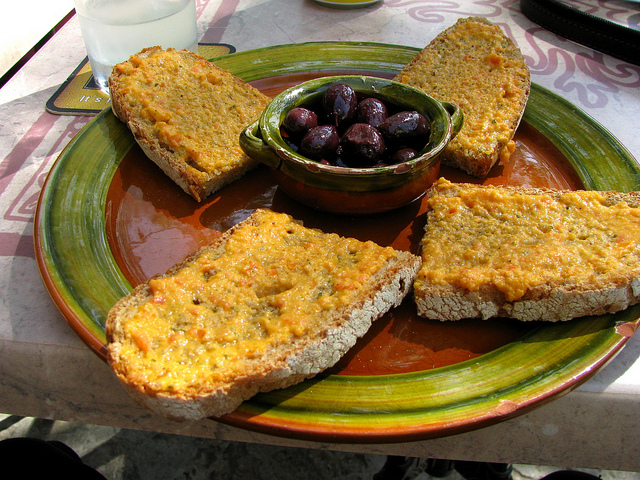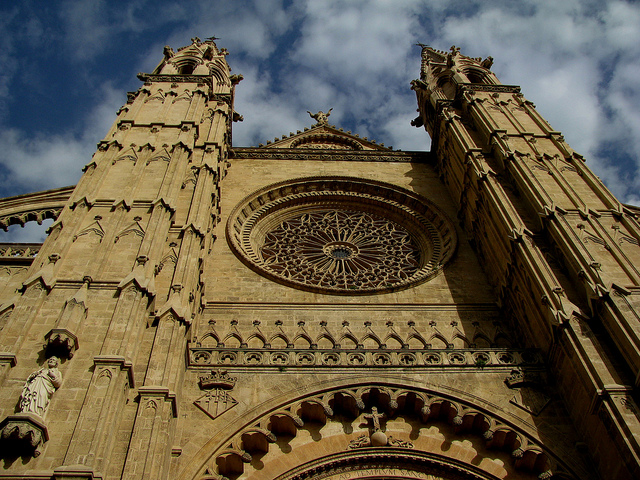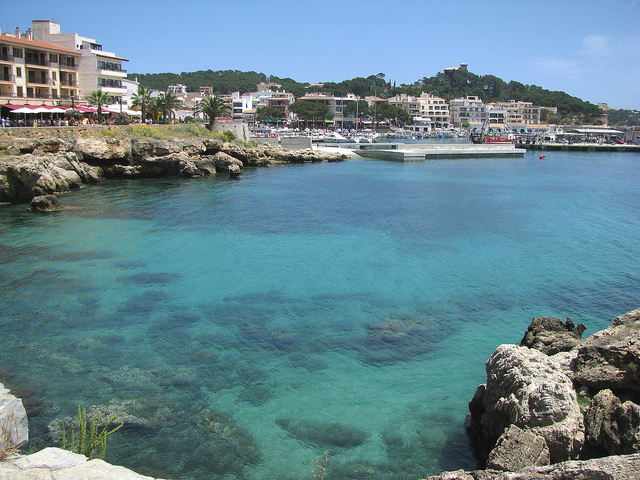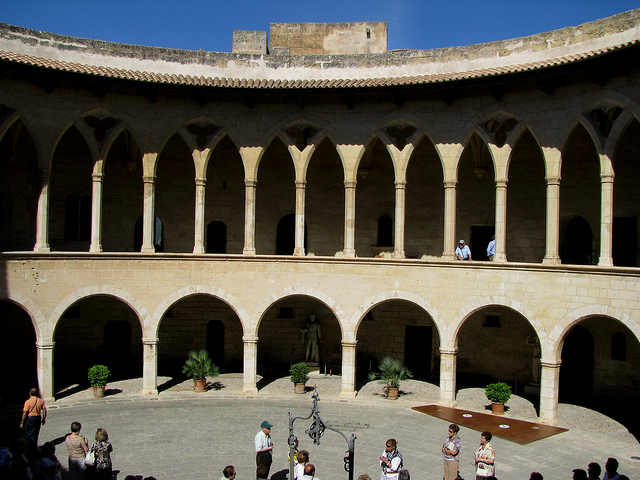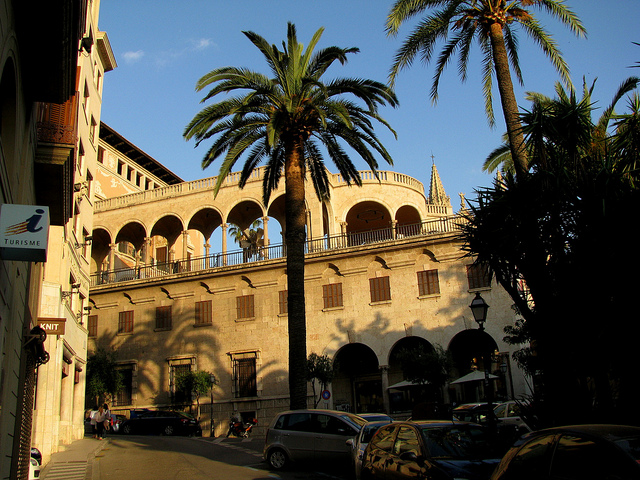I woke up to another day of gorgeous sunshine and took a seat on our spacious balcony at the Torrenova Aparthotel complex. The surrounding view of the Mediterranean was astounding and I still could not believe that we had lucked out with this beautifully located water-front hotel after booking it extremely inexpensively over the Internet.

The train station for the Ferrocarril de Sóller in Palma de Mallorca
Shortly before 10 am we drove on the coastal highway to Palma and my friend dropped me of at the Estació Intermodal on Plaça d’Espanya. My goal today was to take the historic train ride on the famous Ferrocarril de Sóller to the mountain town of the same name. This railway line was constructed in 1911 and opened in 1912 with the profit from the orange and lemon trade that was flourishing in the bowl-shaped mountain valley of Sóller.

The historic train of Sóller, the “Red Arrow”
The vintage electric train was already parked in the Estación de Palma and when I arrived there at 10:40 virtually every seat in the train was taken. While this narrow-gauge train route was originally built as the main line of transport between Sóller and Palma early on in the last century, today it is a major tourist attraction and the vast majority of passengers are tourists from all over the world. I walked all the way to the front of the train to take a picture of the “Red Arrow” vintage electric train and then took my seat in the last wagon.

The interior of the historic train to Sóller
10:50 am was the official departure time, but we did not get going until about 10 minutes later. The train started to slowly and quietly roll away from the station into the streets of Palma where it occupied the median on a major street. Palma’s historic apartment houses started to recede as we headed for the suburbs. Then suburban housing developments gave way to flat agricultural lands that were framed in the north by the impressive Tramuntana mountain chain.

Rural train station along the way
I left my seat and passed through the door of the railcar to take up a spot on the outside platform of the last car in order to have a great panoramic view of the countryside we were traveling through. Every once in a while a fellow traveler would come through the door, take some pictures and disappear again to relax in the comfort of the train car. I enjoyed the warm wind and the great views from the end of the train.

Mallorca countryside from the back of the train
We started to get closer to the mountains, and the flat plain gave way to groves of olive trees and stands of fir trees. Now we were heading into the mountains and started to enter one tunnel after another. Altogether this 27 kilometre long railway route has 13 tunnels, and one of them seemed like it was 10 minutes long. After entering this tunnel I could see the light from the tunnel entrance for several minutes until the train took a turn and I was standing in complete darkness. Standing on the platform with the wind grazing my skin and absolutely no vision at all, I enjoyed this ride, sensing the motion of the train and the gentle air flow on my arms. At some point the experience was almost surrealistic, as if we were headed to the centre of the earth, in total darkness.

Leaving behind one of the many tunnels on the train to Sóller
Once we had crossed the major part of the mountain range the train stopped and several passengers got off to catch some photos of the great panoramic view of the Sóller Valley that opened up below us. Then the train went along the hill slopes southwest of Sóller and within an hour we had arrived at the historic train station in Sóller which is located inside a fortified house dating back to the early 1600. A café and a museum dedicated to the work of Pablo Picasso and Joan Miro are also located inside the train station.

View along the northern coastline of Mallorca
My friend was waiting for me on the main square of Sóller; he had taken the road over the mountain pass of the Tramuntana Mountains. We started our drive into the mountain village of Fornalutx, a tiny hamlet that has won many different prizes and recognition for its beauty and conservation efforts. From here we headed westwards to Deià, another gorgeous mountain village with a great view down towards the northern coastline of the island.

Georgeous view from the Deià cemetery over the Mediterranean coastline
Deià is most well-known for being the long-term home of British poet Robert Graves, who lived here from 1929 until he passed away in 1985. A church is scenically located on the highest point of the village and the view from the adjacent cemetery towards the sea and the mountains is simply breathtaking. The scenery in Mallorca continues to amaze me.

Grave in the cemetery of Deià
Continuing westwards along the coastal road high above the water, we stopped at another one of the island’s main attractions: Son Marroig, the coastal estate of Archduke Ludwig Salvator, a member of the Austrian Habsburg family. Ludwig Salvator first arrived on the island in 1866 and became captivated by the island’s beauty. He even fell in love with a local woman and learned the local Mallorcan dialect. He authored a highly recognized seven-volume work about the history, archeology, folklore and traditions of Mallorca.

Archduke Ludwig Salvator, a huge fan of Mallorca
The estate occupies a gorgeous position high above the coastline and can be visited for 3 Euros. Access exists to the main floor’s common areas and the impressive formal dining room on the second floor whose balconies open up to provide a phenomenal view over the Mediterranean. The estate is surrounded by beautiful gardens and a white marble rotunda at some distance away from the main mansion. The beauty of Mallorca’s north coast becomes evident in Son Marroig.

The famous rotunda at Son Marroig
Our next stop on our country drive was the Port de Valldemossa, a tiny hamlet on the northern coastline that essentially consists of only a couple of restaurants and a handful of houses. To get down to the village we had to drive on a steep narrow road with hair-raising hairpin turns. Back at the top again we went to the inland village of Valldemossa, one of Mallorca’s favourite tourist destinations.

Valldemossa, a pretty mountain village
Valledemossa is an extremely scenic village with cobble-stoned streets and many bars, restaurants and souvenir shops. The main sights in this town are the Real Cartuja (the Royal Charterhouse of Jesus of Nazareth), a Carthusian monastery dating back to the 14th century. Among the famous former residents of this town are composer Frederic Chopin and the French writer and feminist pioneer George Sand who came here to spend the winter of 1838 to 1839. George Sand wrote “A Winter in Mallorca” here which actually painted a rather unflattering portrait of the locals.

Stone cross in Valldemossa
Hollywood stars Michael Douglas and Catherine Zeta-Jones have a home nearby and some years ago they founded a cultural centre called “Costa Nord” which is now owned by the town. We sat down at a nice restaurant with an outdoor patio and enjoyed some savoury local bread with olive oil and tomato paste. Sitting in the shade, we watched the locals and the tourists go about their businesses and I also managed to get my souvenir-shopping done in this town.

One of my favourites: fresh crisp Mallorcan bread with tomato paste & olives
In the late afternoon we drove back to our home base of Palmanova and relaxed on our balcony, overlooking the Mediterranean before we headed out to explore some of the local restaurants. Palmanova features a large selection of British pubs, Italian, Indian and Thai restaurants. We settled in at “Los Curries”, a restaurant with a large second floor patio overlooking the Bay of Palmanova that offers traditional Indian fair. I enjoyed a tasty channa massala while my friend had lamb tikka.

A view over the rooftops of Valldemossa
The restaurant owners were very friendly and provided us with local travel advice. At the end of the evening they offered us two glasses of free orange liqueur which provided a nice ending to another busy day of discoveries in Mallorca.
